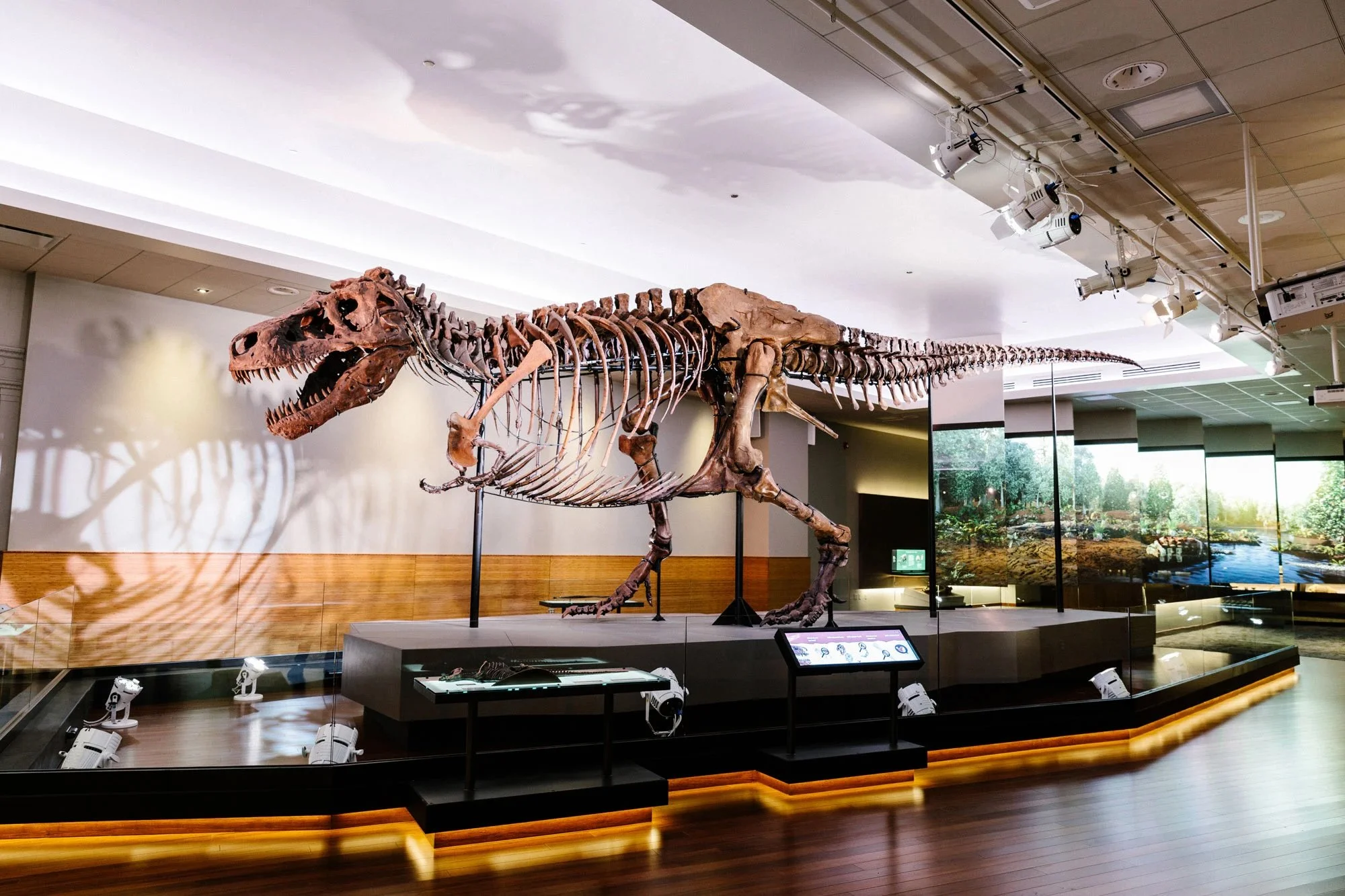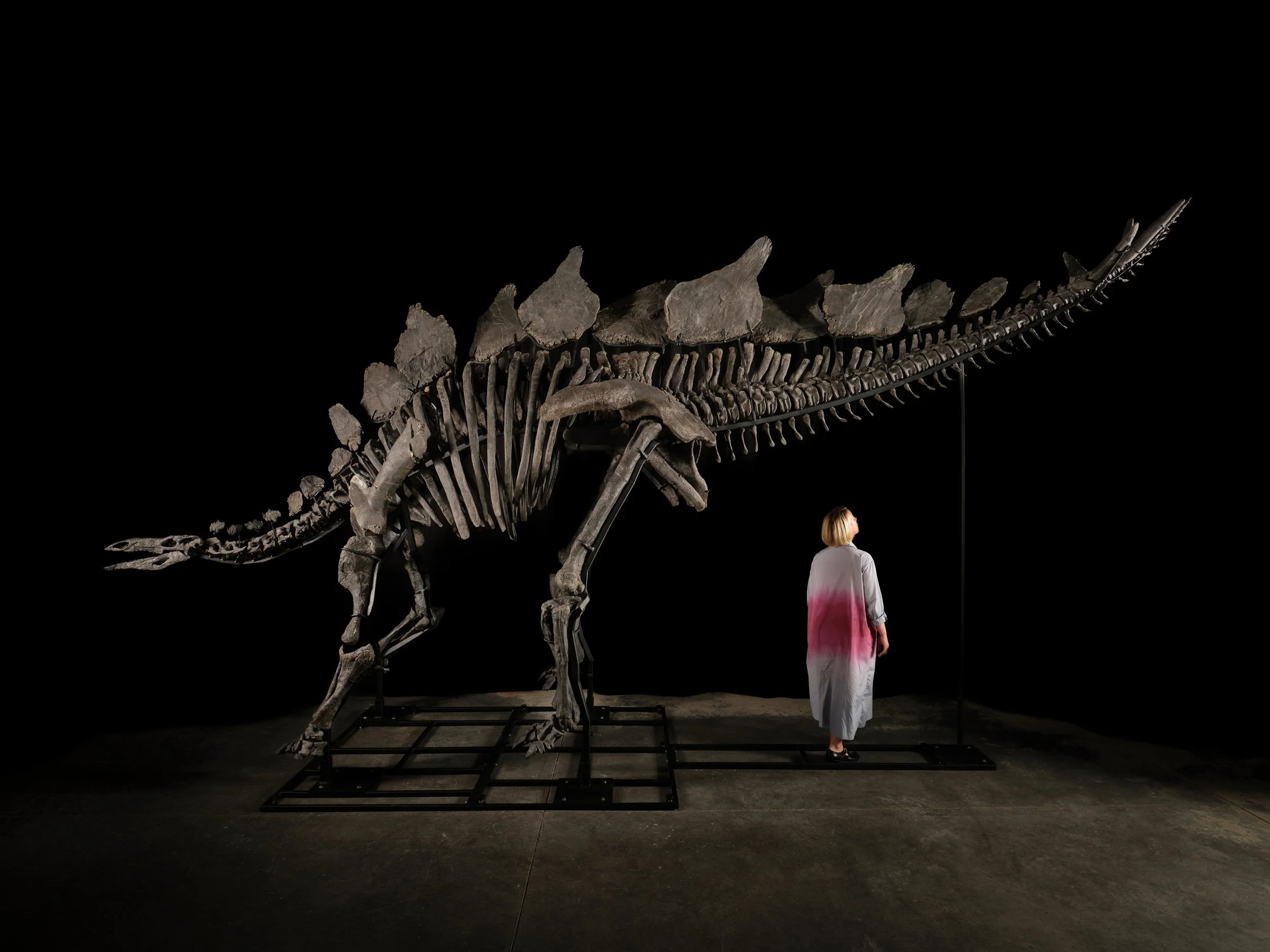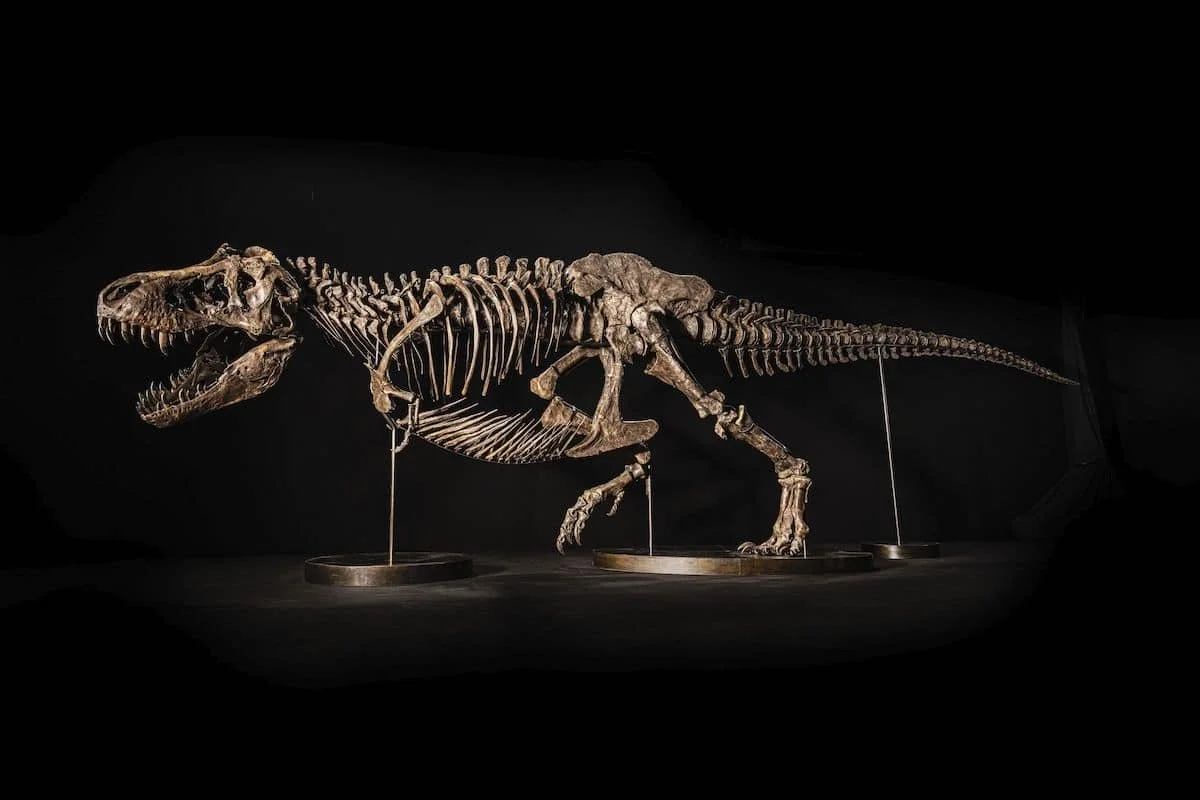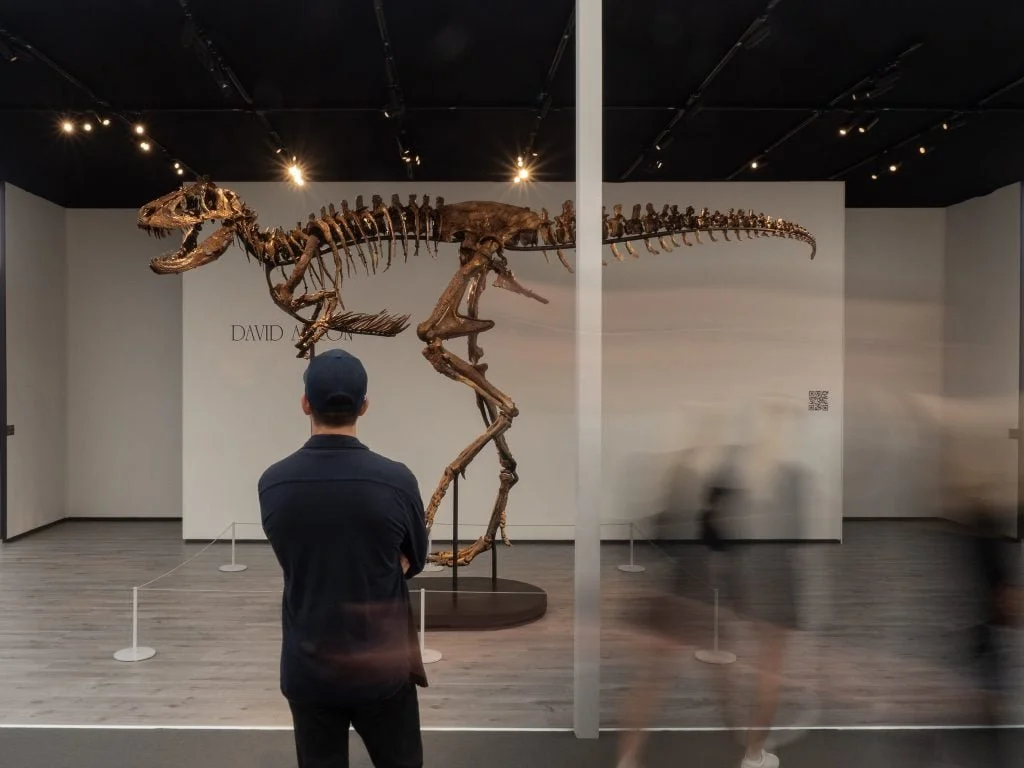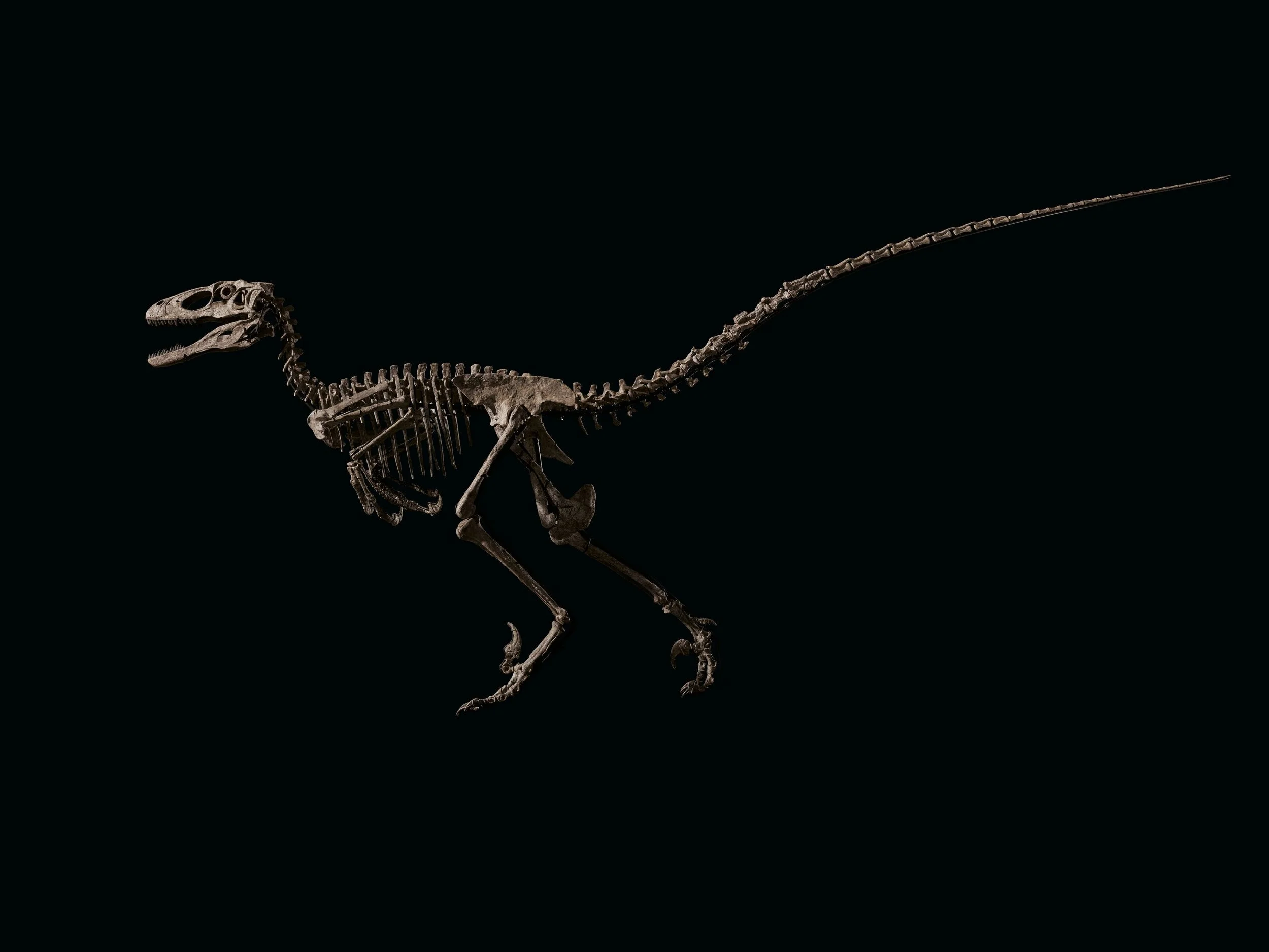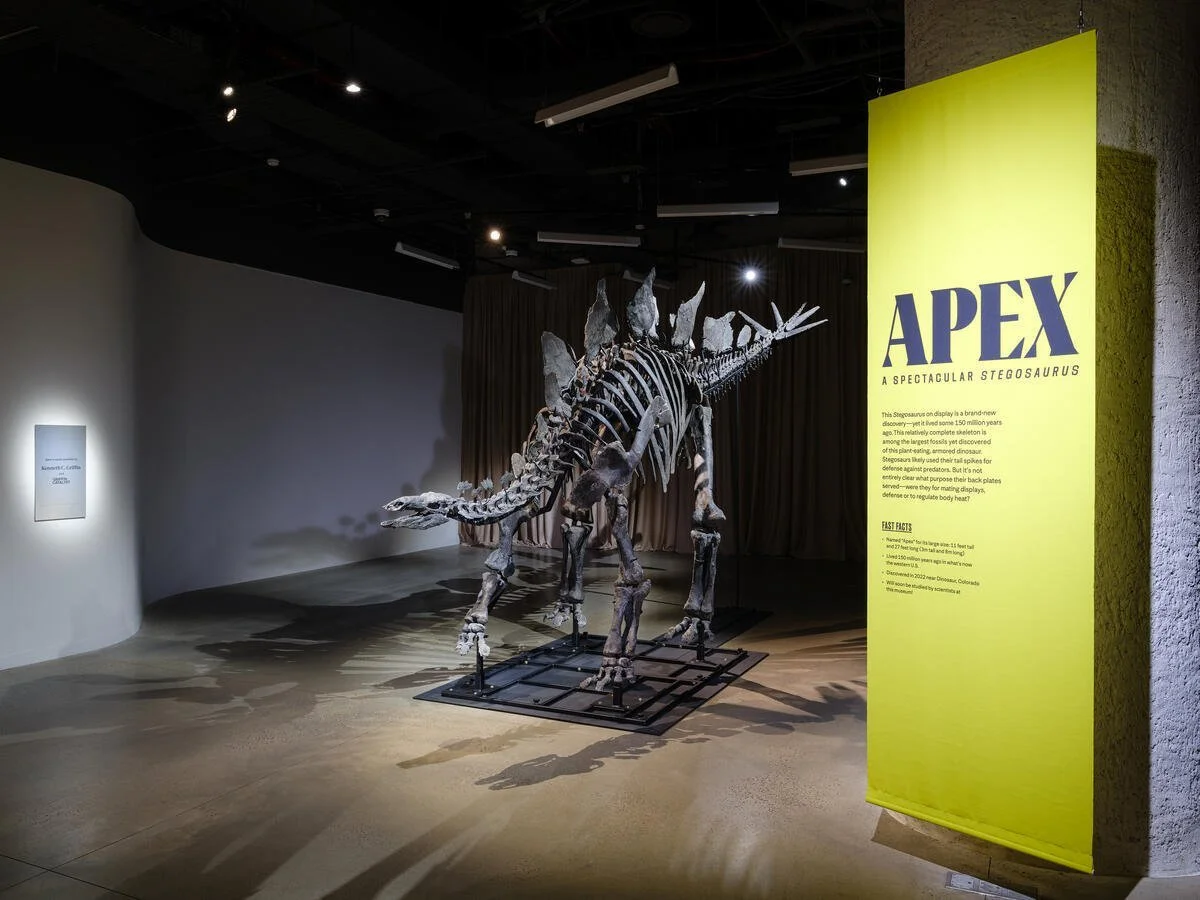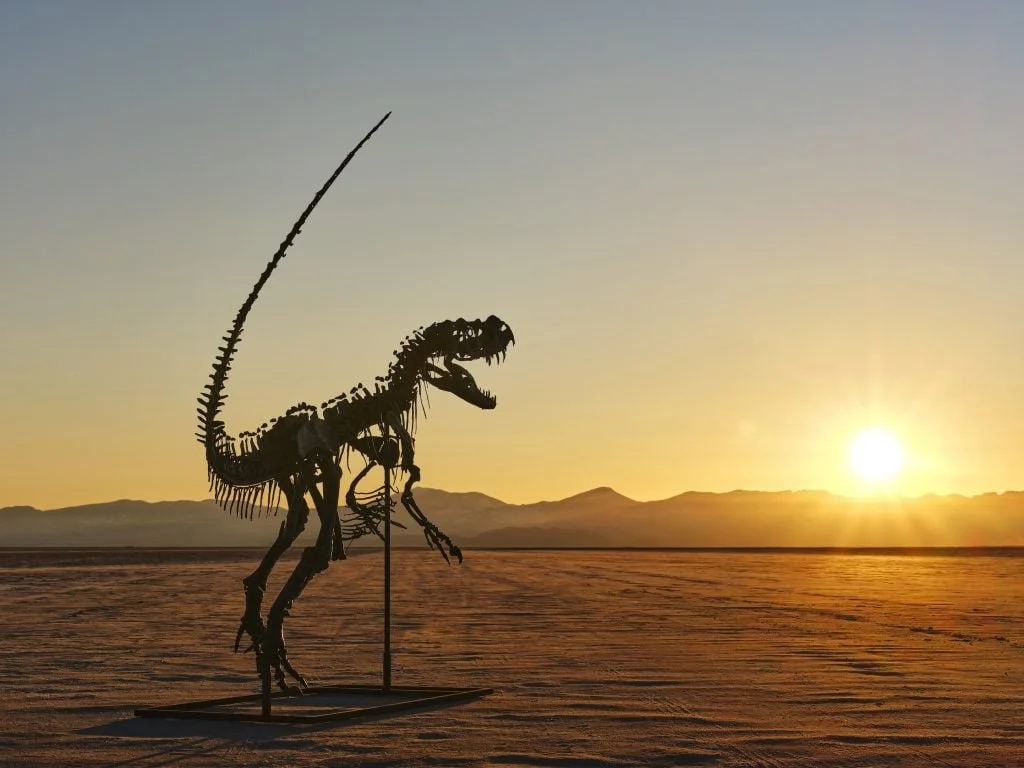The Dinosaur in the Room: Who Has a Right to the Past?
On Wednesday, 16 July, Sotheby’s made headlines with the $30.5 million USD sale of a juvenile Ceratosaurus, making it the third ever highest gross for a near-complete dinosaur skeleton at auction. While this sale made waves in the auction world, it also highlights a growing tension in the fossil market: the escalating value of dinosaur fossils is increasing the motivation of buyers, placing more of these specimens into private hands. This raises serious concerns for the scientific community. The booming private trade of dinosaur fossils brings with it serious questions about the ethical, legal, and scientific dilemmas of this growing market. Particularly, how museums and researchers are finding themselves priced out of their own field.
Photo courtesy: Sotheby’s
The Ceratosaurus, which comes from the Ceratosauria family—literally meaning ‘horned lizards’ —roamed North America during the late Jurassic period, approximately 154–149 million years ago. Measuring in at approximately 6’3” in height, and 10’8” in length, this specimen is one of only four known Ceratosaurus fossils in the world, and the only juvenile. [1] The mounted skeleton was priced at $4-$6 million USD, outgrossing its high estimate by 500%.
The sale of this Ceratosaurus, which has not been given a name, comes almost exactly a year after the sale of a virtually complete Stegosaurus skeleton, named ‘Apex’, which was bought by Hedge Fund billionaire Kenneth Griffin for $45 million USD, and broke the auction record for a complete fossilized skeleton. Apex remains the highest ever grossing lot at a natural history auction. A Tyrannosaurus rex named ‘Stan’, which sold at Christies in 2020 for $31.8 million USD, is the second to come in on this top-three list. Apex had also been valued at $4-$6 million USD, where Stan had been estimated at $6-$8 million. Like the Ceratosaurus, both vastly outperformed those figures.
This Ceratosaurus follows a mounting trend in the auction market for dinosaur fossils—with complete skeletons being the king of this subgenre—and it does not seem to be slowing down. In 2022 alone, several high profile sales made headlines— including a velociraptor, a Gorgosaurus and a T. rex skull.
Sue, the first complete T. rex skeleton sold at Sotheby’s for $8.36 million in 1997. Photo courtesy: Field Museum of Natural History
In 2025, the Geoheritage journal published a study entitled ‘Fossils on the Market: An Attempt to Characterise the Auction World’, which analysed the sales of fossils made by 115 auction houses from January 2010 to December 2022. The study found that dinosaur fossils vastly outperform all other vertebrate fossils, despite only making up about 24% of the market, and have a 95% sell-through rate. The sale of Stan the T. rex alone made up for 35.5% of the total auction revenue generated by fossils in 2020.
But this trend of buying fossilized skeletons within the private market has raised many concerns with paleontologists and the larger scientific community. Prices like those seen in the past five years may already be affecting dig sites; land lease prices have been going up, and there is fear that land owners will see the demand for materials and begin charging higher fees. [2]
Many professionals in the industry have criticized the commercial trade of fossils for turning what should be instruments of scientific discovery into status symbols, taking away from actual research. One paleontologist from the University of Edinburgh, Steve Brusatte, referred to these mounted skeletons as “little more than toys for the rich,” telling the Daily Mail, “Dinosaurs are becoming a commodity traded on the global market, a luxury item affordable only to the wealthiest people, little different than fine art or classic cars or old bottles of whisky…If an oligarch buys a dinosaur skeleton and puts it in the foyer of one of his mansions, then it is effectively lost to science. Gone, a ghost.” [3]
Apex the Stegosaurus. Photo courtesy: Sotheby’s
David Evans, the Vertebrate Paleontology Chair at the Royal Ontario Museum, pointed out what these kinds of funds could be doing for the field if invested in the right areas, telling National Geographic, “If this kind of money [were] invested properly, it could easily fund 15 permanent dinosaur research positions, or about 80 full field expeditions per year, in perpetuity.” [4]
Cassandra Hatton, Vice Chairman of Science and Natural History at Sotheby’s, defended the auction house’s right to sell these types of specimens by claiming that there is no evidence of private ownership being detrimental to science, pointing out how private collectors and institutions can work together through loans and donations, and harkening back to the fact that all great museums once started off as private collections. Saying in a statement to Artnet News, “these specimens have survived for millions of years, and will be around for millions more; while there is a chance they may not be available for study immediately following the sale, they surely will be at some point in the future.” [5]
Stan the T. rex. Photo courtesy: Christie’s
One of the issues raised with the sale of natural history and archeological materials in the United States, as most of the major sales in the past five years have been—including the top three highest grossers—is the lack of patrimony or cultural heritage laws. Many other countries have laws in place that protect any material deemed culturally significant to its land, and place them under the authority of the government; the US has no such laws. While it is illegal to remove or disturb human remains or to excavate on federal land without permission, any archeological fossils found on private land become private property.
Some, like Hatton, argue that private trade and ownership can actually help the scientific community, allowing for those with the means to acquire the specimens to do so, then work with institutions to put them on public display through loans.
Stan was revealed to have been purchased by the Abu Dhabi Department of Culture and Tourism with plans to display him at the Natural History Museum Abu Dhabi, set to open in late 2025, And Apex was loaned to the American Museum of Natural History in New York by its purchaser, Ken Griffin, for a four-year tenure. [6]
A juvenile T. rex nicknamed Chomper, offered by David Aaron Gallery at Frieze Master 2023, on offer for $23 million. Photo courtesy: Frieze Masters
Apex is an interesting case. While his discovery was always meant to be a commercial endeavor—Hatton even worked with his excavation team from discovery straight through to auction, telling the New York Times “Apex was fresh out of the ground, offered with full rights,”—his purchase has created new opportunities for education. [7] In addition to loaning Apex, Griffin also funded a three-year postdoctoral paleontology fellowship at AMNH focused on studying his specimen. After the loan period ends, Apex will be replaced with a cast of his likeness, and while Griffin has pledged to continue making him available for scientific research, it is not known where he will go once his loan expires. [8]
The right to a free market is the so-called dinosaur in the room. Should the government—particularly the United States government—have the right to claim ownership over these discoveries because of their historic and scientific importance? Who has the right to say they know what is best for these materials when they are found on private land? The issue has also been raised that other collectors who might previously have been motivated to donate or lend their collections to public research institutions, will see the ballooning prices and instead choose to sell. [9]
Hector, the Deinonychus antirrhopus, aka Velociraptor, sold at Christie's in 2022 for $12 million. Photo Courtesy: Christie’s
Thomas Carr from Carthage College published a study of his own in 2025 entitled “Tyrannosaurus rex: An endangered species”, in which he used quantitative data from the fossil market, looking specifically at the T. rex, to prove the damage it has done, and will continue to do, to the field of paleontology.
Carr’s study found that of the 132 T. rex specimens deemed to be scientifically significant, only 61 are currently in public trusts where researchers may have access to them, while 71 are in private or commercial hands. He also found that commercial excavations have discovered T. rex fossils at twice the rate of those operated by public museums, and that only 11% of T. rex fossils recovered by private companies will end up in public collections. As well, juvenile and subadult T. rex specimens, which Carr argues are crucial for understanding growth, represent 20% of privately owned specimens, and leave these scientifically valuable materials inaccessible to researchers. He claims, “in the case of T. rex, the market has reduced the sample size to below the number required to quantitatively test hypotheses...” The proliferation of private excavation being undertaken with the sole purpose of a payday, such as with Apex, may take away key pieces in the puzzle of evolution. Carr argues that previous study and discovery that could be expanded upon or improved is being greatly hindered by this private market.
Carr also argues that the eye-watering sums fossils are fetching nowadays exclude most public museums and institutions from even attempting to acquire them on the auction market. Even our Ceratosaurus that last month may have deeper implications in this vein. The near-complete skeleton had previously been at the Museum of Ancient Life in Utah, where it remained since its discovery (by private fossil prospectors) in 1996. McKay Christensen, the chief executive of Thanksgiving Point, which owns the museum, told the New York Times that the proceeds from his sale, “are critical and necessary to our ongoing sustainability, and exclusively reserved and used to maintain and protect our collections, educate visitors and further expand our collections.” [10] This claim forces one to wonder if this new market trend will motivate museums who are strapped for cash to consider de-acquisitioning some of their specimens.
Apex the Stegosaurus on view in the American Museum of Natural History. Photo courtesy: Alvaro Keding & Daniel Kim/© AMNH via artnet.
The loss of data and opportunities for discovery extend beyond just those of the fossils themselves. Carr’s study found that discovery for the purpose of sale and not scientific understanding excludes the geological context around a fossil if it is not pertinent to its commercial value. The study says, “Without reliable locality data, commercially collected T. rex fossils cannot be put into the larger chronostratigraphic context with the rest of the faunal community…the commercial and private ownership of T. rex fossils has resulted in a tremendous amount of data loss since the entirety of the data—from the bones to the enclosing rock—are scientifically informative.” [11]
Commercial and for-profit paleontology is not a new industry, and fossils as well as natural history auctions have been around for years. But the monumental uptick in the going price for dinosaur fossils may have far-reaching consequences. The push and pull of government oversight and control with privatization and capitalist pursuits is as old as the United States itself. The ethical question of whether or not researchers and those in pursuit of scientific discovery are more deserving of these materials than those with a passion for the subject who have the capital to obtain them, is one without a straight-forward answer. There is also the issue of the physical resource—fossilized remains of pre-historic life are finite, and selling off what little is actually available will inevitably interfere with research and understanding. Take, for example, the fact that there are only four Ceratosaurus skeletons in the world, and the one that sold last week is the only juvenile. It is still unknown who purchased the dinosaur and what they intend to do with it, but either way, paleontologists may have lost the chance to discover new information about how this breed of dinosaur grew, and what their habits might have been in pre-adulthood. Science and factual discovery are already under attack in the US, and the incentive for profit-over-science is causing land leases to be more expensive and museums to lose out on obtaining new specimens that sell at 500% above their expected price-range.
Future solutions may lie in regulation, transparency, the commitment of auction houses or collectors to comprehensive scientific research, or fostering partnerships between the private and public sectors. While the free market can claim ownership, it will never outweigh the importance of curiosity, the pursuit of knowledge and discovery.
The Sotheby’s Ceratosaurus. Photo courtesy: Matthew Sherman via artnet
Basha Shapiro
Art Markets Co-Editor, MADE IN BED
Notes
[1] Sotheby’s. “Ceratosaurus | Natural History, Including the Juvenile Ceratosaurus, and the Largest Piece of Mars on Earth | Science | Sotheby’s,” 2024.
[2] Asher Elbein, “Sotheby’s to Auction a Ceratosaurus, with Millions and More on the Line,” The New York Times, June 16, 2025.
[3] Stacy Liberatore, “Furious Paleontologists Blast Auction Houses for Letting the Super Rich Buy up Dinosaur Specimens,” Mail Online (Daily Mail, August 20, 2022).
[4] Michael Greshko, “‘Stan’ the T. Rex Just Sold for $31.8 Million—and Scientists Are Furious,” National Geographic, October 12, 2020.
[5] “‘They Are Thieves of Time’: Dismayed Paleontologists Speak out against the Booming Market for Dinosaur Skeletons | Artnet News,” Artnet News, August 22, 2022.
[6] Zachary Small and Julia Jacobs, “World’s Priciest Dinosaur Fossil Comes to Museum of Natural History,” The New York Times, December 5, 2024.
[7] Zachary Small and Julia Jacobs, “World’s Priciest Dinosaur Fossil Comes to Museum of Natural History,” The New York Times, December 5, 2024.
[8] Zachary Small and Julia Jacobs, “World’s Priciest Dinosaur Fossil Comes to Museum of Natural History,” The New York Times, December 5, 2024.
[9] Michael Greshko, “‘Stan’ the T. Rex Just Sold for $31.8 Million—and Scientists Are Furious,” National Geographic, October 12, 2020.
[10] Asher Elbein, “Sotheby’s to Auction a Ceratosaurus, with Millions and More on the Line,” The New York Times, June 16, 2025.
[11] Thomas D. Carr, “Tyrannosaurus Rex: An Endangered Species,” Palaeontologia Electronica 28(1):a16 (March 26, 2025).
Sources
Artnet News. “‘They Are Thieves of Time’: Dismayed Paleontologists Speak out against the Booming Market for Dinosaur Skeletons | Artnet News,” August 22, 2022. https://news.artnet.com/market/paleontologists-speak-out-against-dinosaur-sales-2163387
Asher Elbein. “Ceratosaur Fossil Auctioned for $30.5 Million by Sotheby’s.” The New York Times, July 16, 2025. https://www.nytimes.com/2025/07/16/science/sothebys-dinosaur-auction-ceratosaurus.html.
“Sotheby’s to Auction a Ceratosaurus, with Millions and More on the Line.” The New York Times, June 16, 2025. https://www.nytimes.com/2025/06/16/science/dinosaur-fossil-auction-sothebys.html.
Batycka, Dorian. “Dino-Mania Shows No Sign of Extinction as Sotheby’s Offers a Rare Gorgosaurus Skeleton Estimated up to $8 Million | Artnet News.” Artnet News, July 6, 2022. https://news.artnet.com/market/sothebys-gorgosaurus-skeleton-8-million-2142470.
Benzine, Vittoria. “Apex, the $44 Million Stegosaurus Skeleton, Enters a New York Museum.” Artnet News, December 6, 2024. https://news.artnet.com/art-world/apex-stegosaurus-american-museum-natural-history-2582239.
“Can Dinomania Strike Twice? Christie’s Is Selling a Full T. Rex Skeleton—a $25 Million Specimen Named Shen—in Hong Kong | Artnet News.” Artnet News, September 30, 2022. https://news.artnet.com/market/can-dinomania-strike-twice-christies-is-selling-a-full-t-rex-skeleton-a-25-million-specimen-named-shen-in-hong-kong-2183896.
Brian Boucher. “Rare Dinosaur Fossil Nets a Jaw-Dropping $30.5 Million at Auction.” Artnet News, July 16, 2025. https://news.artnet.com/art-world/unique-juvenile-dinosaur-sothebys-2659142.
Brinkhof, Tim. “Dinosaur Skeletons Auctioned by Christie’s Sell for $15 Million.” Artnet News, December 12, 2024. https://news.artnet.com/art-world/christies-allosaurus-dinosaurs-auction-result-2586343.
Carr, Thomas D. “Tyrannosaurus Rex: An Endangered Species.” Palaeontologia Electronica 28(1):a16 (March 26, 2025).
Christies.com. “TYRANNOSAURUS REX, SOUTH DAKOTA, USA | Christie’s.” Christie’s, 2020. https://www.christies.com/en/lot/lot-6283836.
Cichowski, Heather. “Everything You Need to Know about the Upcoming Natural History Museum Abu Dhabi | Time out Abu Dhabi.” Time Out Abu Dhabi, June 13, 2023. https://www.timeoutabudhabi.com/culture/art/natural-history-museum-abu-dhabi.
Elbein, Asher. “Apex, the Largest Stegosaurus Fossil Ever Found, Heads to Auction.” The New York Times, May 29, 2024, sec. Science. https://www.nytimes.com/2024/05/29/science/stegosaurus-fossil-auction-sothebys.html.
Feldman, Ella. “Christie’s Calls off T. Rex Auction Expected to Fetch $25 Million.” Smithsonian Magazine, November 22, 2022. https://www.smithsonianmag.com/smart-news/christies-calls-off-t-rex-auction-expected-to-bring-in-25-million-180981167.
Gapper, John. “Christie’s Has Brought the Dinosaur Auction Show to London.” The Straits Times, December 11, 2024. https://www.straitstimes.com/opinion/christies-has-brought-the-dinosaur-auction-show-to-london.
Goldstein, Caroline. “Abu Dhabi Has Been Unmasked as the New Owner of Stan the T. Rex, Which Sold at Christie’s for $31.8 Million | Artnet News.” Artnet News, March 23, 2022. https://news.artnet.com/art-world/stan-t-rex-goes-to-abu-dhabi-museum-2089251.
Goldstein, Caroline. “Christie’s Auctioned off a Velociraptor Skeleton for $12.4 Million, Eviscerating Its $6 Million Estimate | Artnet News.” Artnet News, May 13, 2022. https://news.artnet.com/art-world/dinosaur-skeleton-christies-2114482.
Greshko, Michael. “‘Stan’ the T. Rex Just Sold for $31.8 Million—and Scientists Are Furious.” National Geographic, October 12, 2020. https://www.nationalgeographic.com/science/article/stan-tyrannosaurus-rex-sold-at-auction-paleontologists-are-furious.
“Stan the T. Rex Found! World’s Most Expensive Fossil Finds Home in a New Museum.” National Geographic, March 23, 2022. https://www.nationalgeographic.com/science/article/stan-the-t-rex-found-worlds-most-expensive-fossil-finds-home-in-a-new-museum.
Guruji, Prateeksha. “Nature as True Luxury: The Rise of Natural History Auctions - LuxuryFacts: News, Reviews, Features on Luxury.” LuxuryFacts: News, Reviews, Features on Luxury, March 3, 2021. https://luxuryfacts.com/nature-as-true-luxury-the-rise-of-natural-history/?utm_source=chatgpt.com.
“Art Industry News: It Turns out There’s a Ferocious Family Feud behind Stan, the $32 Million T-Rex Sold at Christie’s + Other Stories.” Artnet News, October 23, 2020. https://news.artnet.com/art-world/art-industry-news-october-23-2020-1917753.
Kinsella, Eileen. “A $28 Million T-Rex Skeleton Was the Undisputed King of Christie’s Otherwise Muted $341 Million Contemporary Art Auction.” Artnet News, October 6, 2020. https://news.artnet.com/market/christies-evening-october-2020-1913623.
Liberatore, Stacy. “Furious Paleontologists Blast Auction Houses for Letting the Super Rich Buy up Dinosaur Specimens.” Mail Online. Daily Mail, August 20, 2022. https://www.dailymail.co.uk/sciencetech/article-11117517/Furious-paleontologists-blast-auction-houses-letting-super-rich-buy-dinosaur-specimens.html?ns_mchannel=rss&ns_campaign=1490&ito=1490.
Mueller, Benjamin. “Trump Administration Has Begun a War on Science, Researchers Say.” The New York Times, March 31, 2025. https://www.nytimes.com/2025/03/31/science/trump-science-nas-letter.html.
Ragni, Cinzia, Giorgia Bacchia, Marco Peter Ferretti, and Massimo Delfino. “Fossils on the Market: An Attempt to Characterise the Auction World (2010–2022).” Geoheritage 17, no. 39 (2025).
Rogers, Kristen, and Yenny Sanchez. “Scientists Are Concerned about the Million Dollar Auction of This Dinosaur Skeleton.” CNN, July 28, 2022. https://www.cnn.com/style/article/gorgosaurus-dinosaur-skeleton-auction-scn.
Rossi, Andrew. “Record $45 Million for Stegosaurus Could Prompt Finders to Sell rather than Donate.” Cowboy State Daily, July 20, 2024. https://cowboystatedaily.com/2024/07/20/record-45-million-for-stegosaurus-could-prompt-finders-to-sell-rather-than-donate/.
Sarah Cascone. “Stegosaurus Skeleton Sells for a Whopping $44 Million.” Artnet News, July 17, 2024. https://news.artnet.com/art-world/44-million-stegosaurus-skeleton-sothebys-sale-2513335.
Simons, Lewis M. “Fossil Trade Article, Dinosaur Fossils Information, Facts -- National Geographic.” Science. National Geographic, December 2, 2009. https://www.nationalgeographic.com/science/article/fossil-wars.
Small, Zachary. “T. Rex Skeleton Brings $31.8 Million at Christie’s Auction.” The New York Times, October 7, 2020. https://www.nytimes.com/2020/10/06/arts/design/t-rex-skeleton-brings-31-8-million-at-christies-auction.html.
Small, Zachary, and Julia Jacobs. “World’s Priciest Dinosaur Fossil Comes to Museum of Natural History.” The New York Times, December 5, 2024. https://www.nytimes.com/2024/12/05/arts/most-expensive-stegosaurus-american-museum-of-natural-history.html.
Society for American Archaeology. “Archaeology Law & Ethics.” Society for American Archaeology, 2014. https://www.saa.org/about-archaeology/archaeology-law-ethics.
Sotheby’s. “Ceratosaurus | Natural History, Including the Juvenile Ceratosaurus, and the Largest Piece of Mars on Earth | Science | Sotheby’s,” 2024. https://www.sothebys.com/en/buy/auction/2025/natural-history-2/ceratosaurus?locale=en.
Sotheby's. “Discovering and Unearthing a 150 Million Year Old Dinosaur: Meet Apex the Stegosaurus | Sotheby’s.” YouTube, July 10, 2024. https://www.youtube.com/watch?v=1rkIzfrRDOE.
Sotheby’s. “Stegosaurus | Natural History, Including Apex the Stegosaurus | Science | Sotheby’s,” 2022. https://www.sothebys.com/en/buy/auction/2024/natural-history/stegosaurus?locale=en.
Sotheby’s. “Tyrannosaurus Rex Skull | Maximus Rex | 2022 | Sotheby’s,” 2022. https://www.sothebys.com/en/buy/auction/2022/maximus-rex/tyrannosaurus-rex-skull.
Sothebys.com. “Cassandra Hatton, SVP | Vice Chairman, Science and Natural History | Sotheby’s,” 2016. https://www.sothebys.com/en/about/team/cassandra-hatton.
Sothebys.com. “Historic Bidding Battle for Stegosaurus Fossil Sets New Auction Record at $44.6 Million.” Sotheby’s, July 17, 2024. https://www.sothebys.com/en/videos/historic-bidding-battle-for-stegosaurus-fossil-sets-new-auction-record-at-44-6-million.
Whiddington, Richard. “Private Ownership of Dino Fossils Hinders Scientific Progress, Study Finds.” Artnet News, April 23, 2025. https://news.artnet.com/art-world/privately-held-dinosaur-fossils-hinder-science-study-2635279.
“Sotheby’s Auction of a T. Rex Skull, Expected to Fetch $20 Million, Sold for a Not-So-Kingly $6.1 Million | Artnet News.” Artnet News, December 9, 2022. https://news.artnet.com/market/sothebys-auction-tyrannosaurus-rex-skull-under-estimate-2227065.
Woodward, Aylin. “Ken Griffin’s $44.6 Million Dinosaur Has a New Home.” archive.ph. The Wall Street Journal, December 5, 2024. https://archive.ph/VdmxI#selection-5929.148-5929.329.
“Rich People Love Dinosaur Bones and Scientists Are Feeling Left Out.” archive.ph. The Wall Street Journal, November 29, 2024. https://archive.ph/bm6zF.



